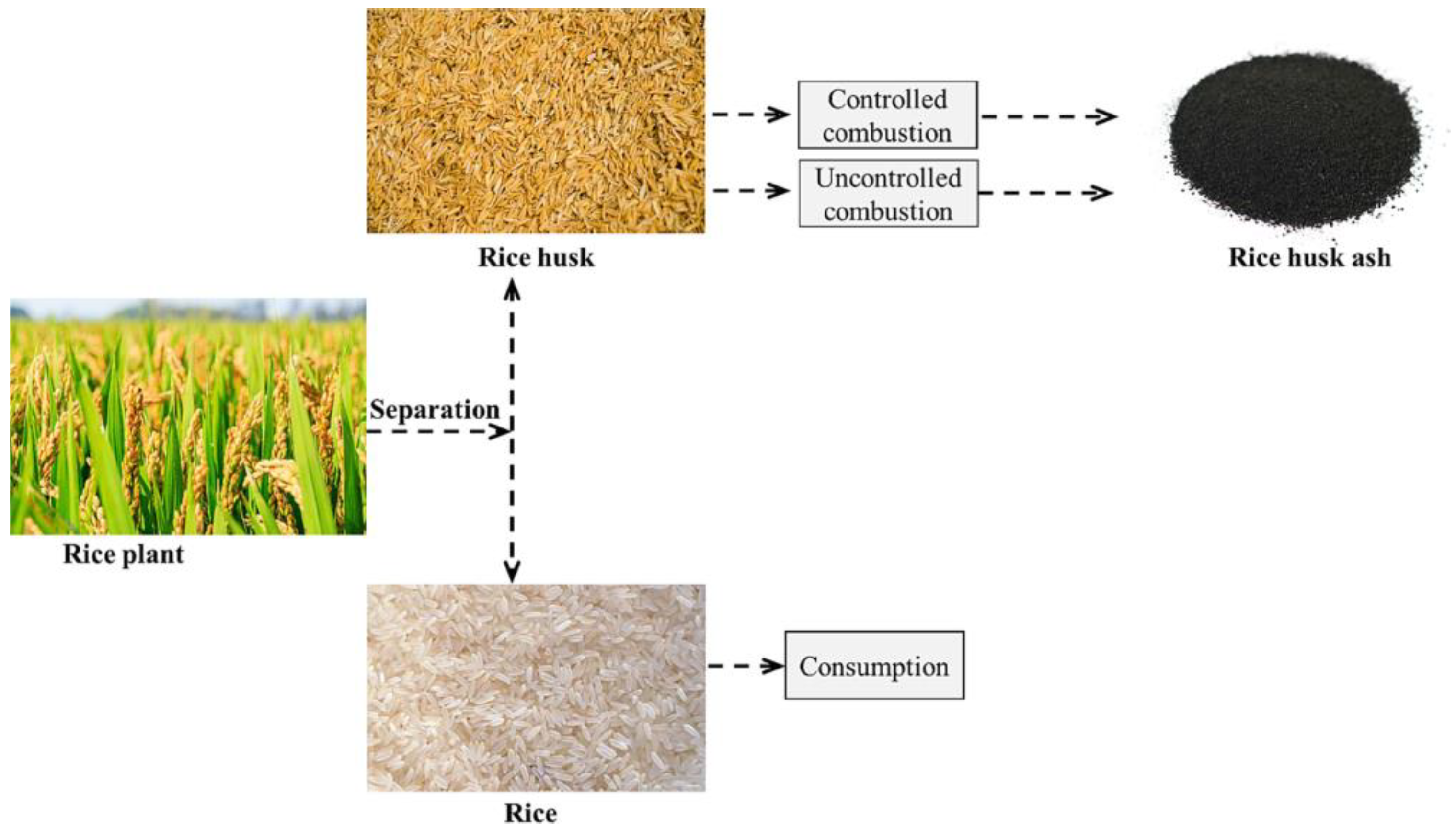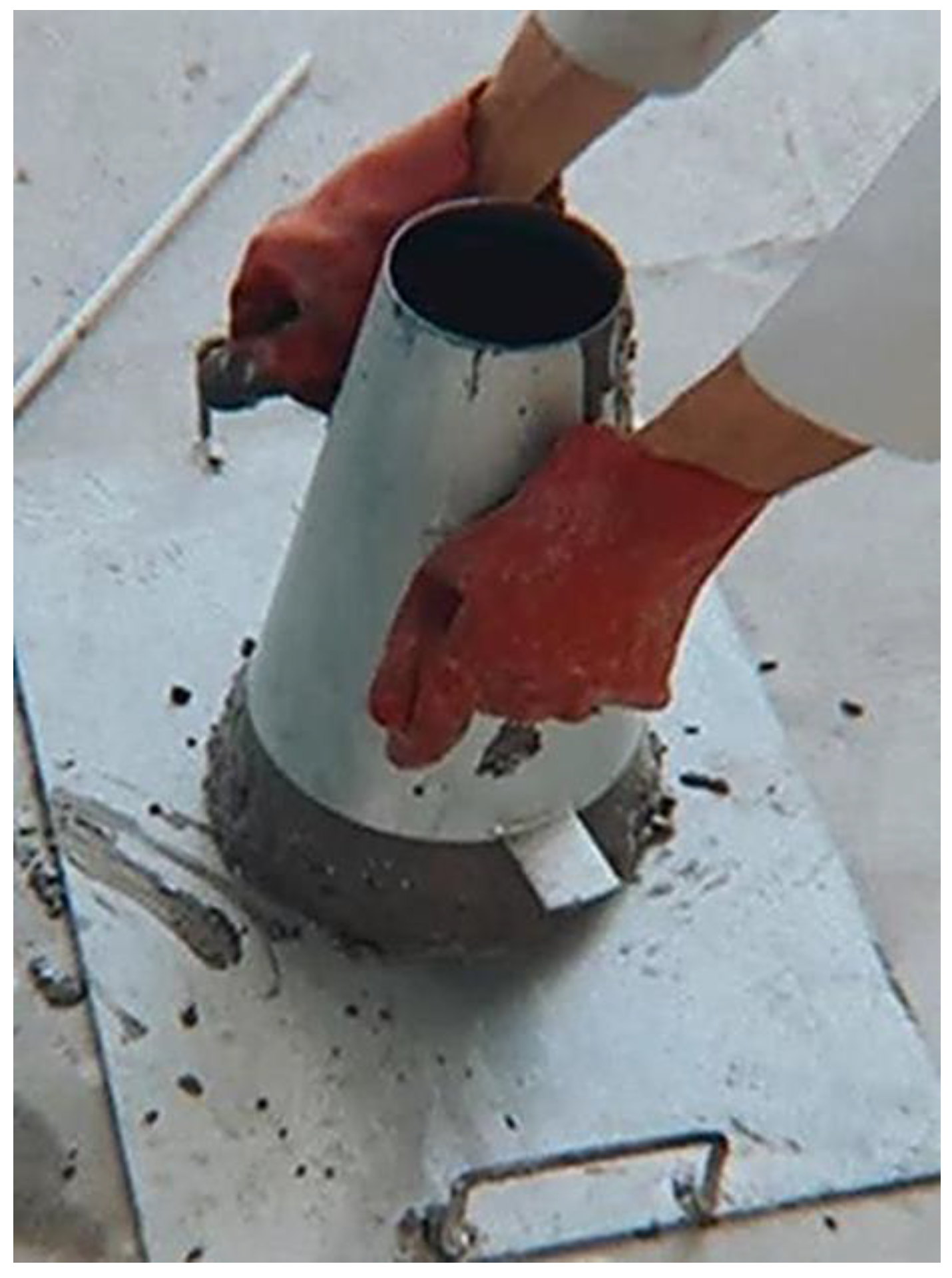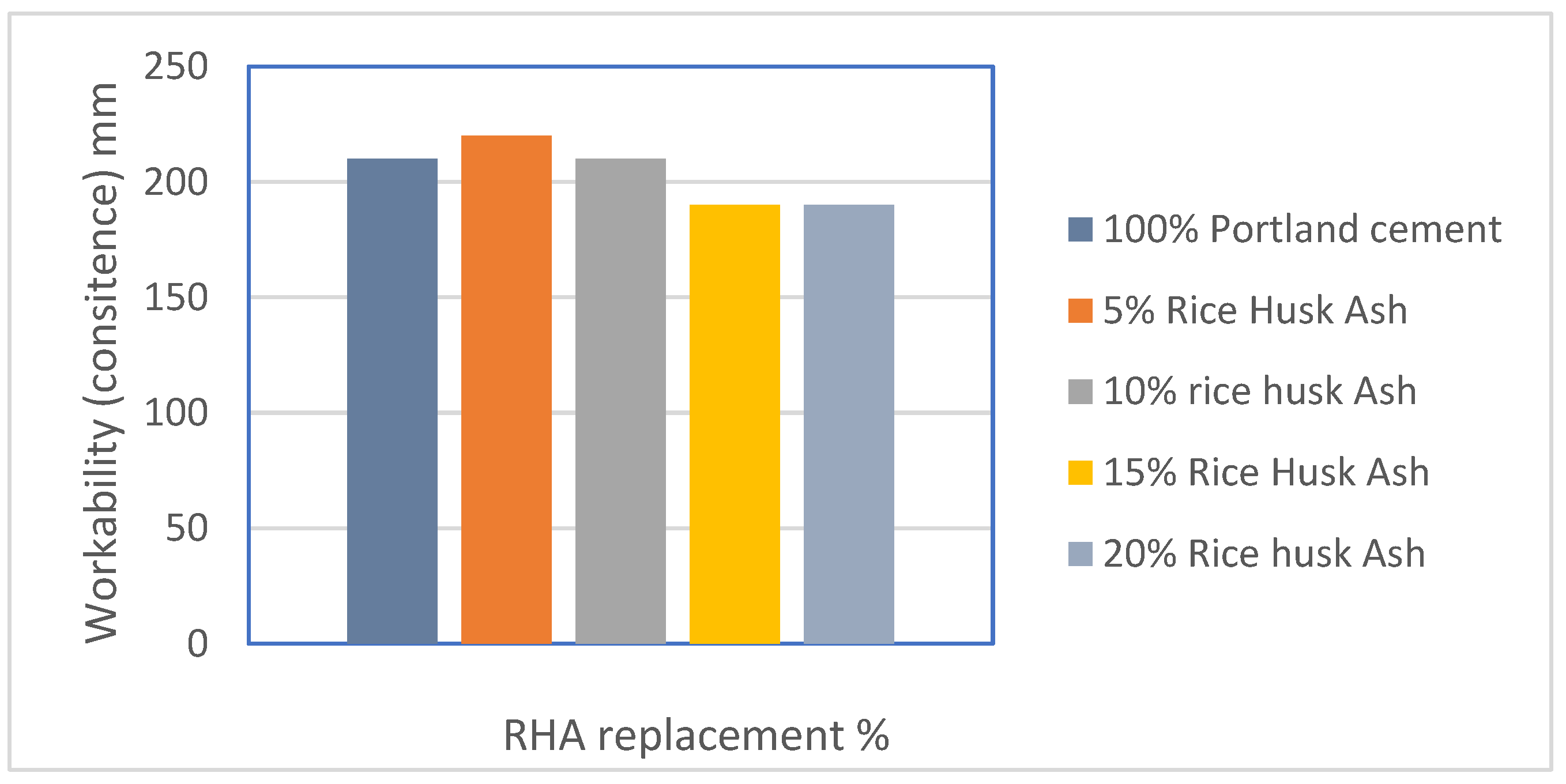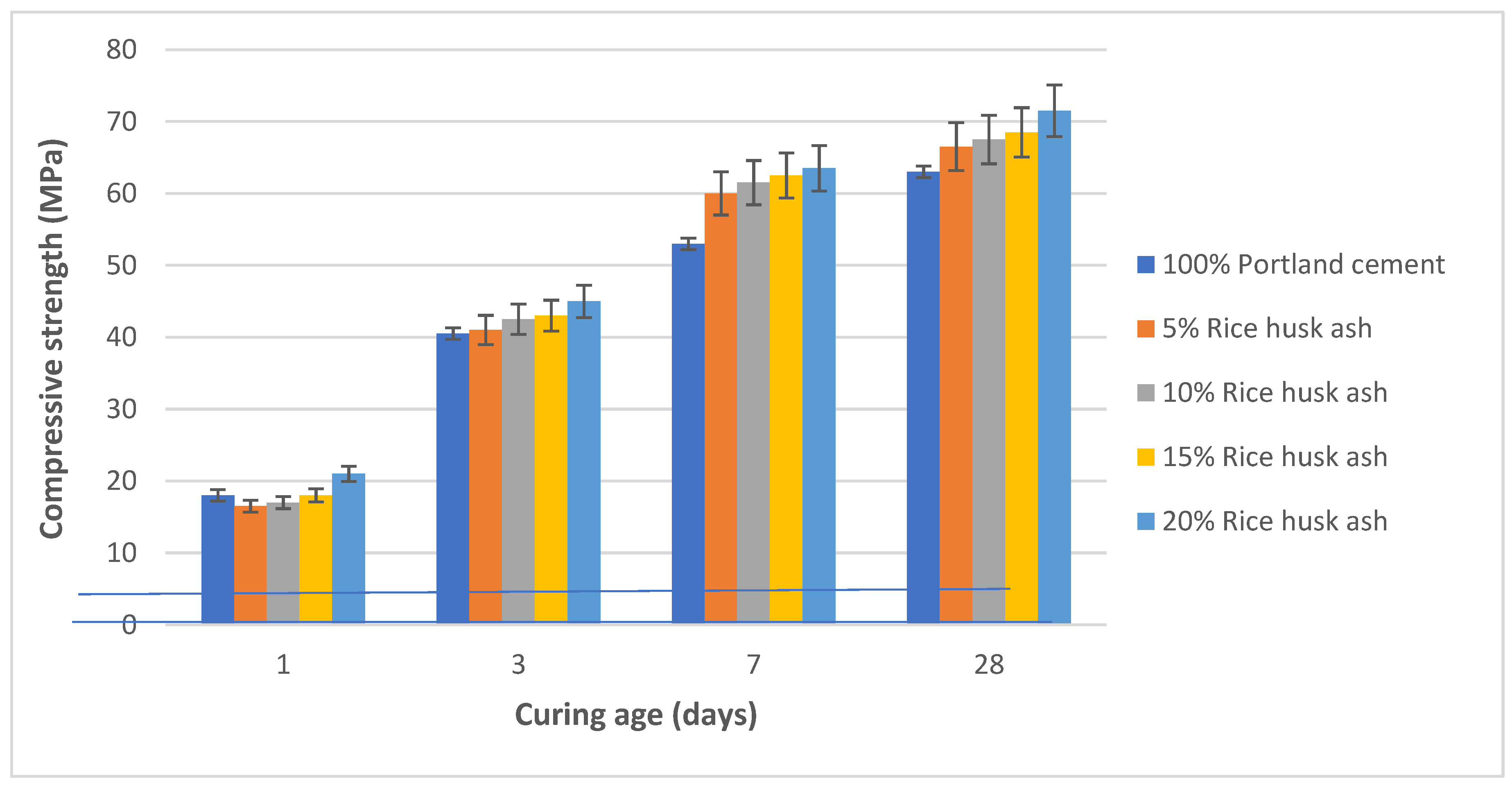The Effects of Rice Husk Ash as Bio-Cementitious Material in Concrete
Abstract
:1. Introduction
2. Materials and Method
2.1. Materials
2.1.1. Cement
2.1.2. Rice Husk Ash
- -
- Silica content is high in RHA samples compared with other constituents.
- -
- RHA was observed to have high loss on ignition (LOI). This can be attributed to the carbonisation in the range of 400–600 °C. [25].
- -
- There is low alkali content, with obtained Na2O value being much lower than 3, indicating no extensive cracking and, consequently, no adverse effects on the mechanical properties of the concrete [26].
2.1.3. Aggregates and Sand
Fine Aggregate
Coarse Aggregate
Washed Sand
2.2. Instrumentation
2.2.1. Pan-Type Mixer
2.2.2. Slump Cone Test
2.2.3. Cube Moulds
2.2.4. Compressive Strength Test
2.3. Procedure
2.3.1. Sample Preparation
- -
- The mix design, as per the specifications and aggregate gradation report, was prepared and calculated as per batch.
- -
- The aggregate, cement, water, and admixture were weighed as per batch size (0.02 m3 to 0.045 m3).
- -
- The moisture correction and absorption were considered as per the testing of aggregate samples, and the water content in mix was adjusted.
2.3.2. Mixing Procedure
- -
- Half quantity of coarse aggregate was added in the mixer.
- -
- Total fine aggregates was added to coarse aggregate.
- -
- After fine aggregate, remaining coarse aggregate was added and spread evenly with scoop.
- -
- Aggregates (fine and coarse) were mixed for 15–30 s.
- -
- Approximately half quantity of water was added and continued mixing for next 15–30 s.
- -
- Mixer was stopped, and contents were left for 3–5 min to allow water absorption by aggregates.
- -
- All cementation materials (PC and RHA) were added and spread evenly over the aggregate and mixed for 15–30 s.
- -
- Mixer was stopped and removed the material adhering from the sides and blades of mixer.
- -
- The remaining water was added together with admixture and mixed it for 2–3 min.
- -
- The mixer was stopped, and the concrete was checked with a trowel for uniformity.
2.3.3. Mix Proportions
2.3.4. Testing
Slump Cone Test
- -
- The workability/consistency test (slump cone) was carried out in accordance with BS EN 12350-2:2000 [29].
- -
- The concrete was poured in three layers; each layer was tapped twenty-five times.
- -
- The cone was removed after tapping; then, the concrete slumped, and the amount of the minimum concrete slump was measured in millimetres.
Fresh Concrete Tests
Compressive Strength Test
- -
- The compressive strength of the concrete cubes was measured after 1 day, 3 days, 7 days, and 28 days of the casting day by placing them in compressive strength machine conforming to BS EN 12390-3:2002 [31] and applying compressive load at a rate of 0.23 MPa/s. Compression load was applied to the concrete samples until cracking failure of the concrete. The load was recorded in kN, and strength was recorded in MPa.
3. Results and Discussion
3.1. Effects of RHA on Concrete Workability and Air Content
3.2. Effects of RHA on the Compressive Strength of Concrete
3.3. The Effects of RHA on the Density of Concrete
4. Conclusions
- The inclusion of rice husk ash in concrete at 10–20% partial replacement of Portland cement improved the strength of concrete starting 1 day after curing and up to 28 days.
- There is also a reduction in the air content of the concrete, indicating improvement in the durability of concrete containing rice husk ash.
- Rice husk ash can help produce lighter concrete without impairing its strength property. Therefore, lighter concrete can be produced with similar or improved compressive strengths to that of 100% PC concrete.
- Concrete can maintain its workability despite including rice husk ash in the cementitious content.
- The improvement in concrete strength might provide the potential for the increased use and application of concretes containing RHA that would be of further benefit to the environment.
Author Contributions
Funding
Data Availability Statement
Conflicts of Interest
References
- Aprianti, E.; Shafigh, P.; Bahri, S.; Farahani, J.N. Supplementary cementitious materials origin from agricultural wastes—A review. Constr. Build. Mater. 2015, 74, 176–187. [Google Scholar] [CrossRef]
- Aprianti, S.E. A huge number of artificial waste material can be supplementary cementitious material (SCM) for concrete production—A review part II. J. Clean. Prod. 2017, 142, 4178–4194. [Google Scholar] [CrossRef]
- Domone, P. Concrete. In Construction Materials—Their Nature and Behaviour; Domone, P., Illston, J., Eds.; Taylor and Francis: London, UK, 2010. [Google Scholar]
- World Cement Association. Available online: https://www.worldcementassociation.org/about-us/sustainability (accessed on 18 August 2024).
- Al-Ahdal, B.M.S.; Li, X.; Tufail, R.F. Mechanical properties of concrete containing waste glass powder and rice husk ash. Biosyst. Eng. 2018, 4, 1019–1033. [Google Scholar]
- Samad, S.; Shah, A. Role of binary cement including Supplementary Cementitious Material (SCM), in production of environmentally sustainable concrete: A critical review. Int. J. Sustain. Built Environ. 2017, 6, 663–674. [Google Scholar] [CrossRef]
- Molhotra, V.M. Fly Ash, Slag, Silica Fume, and Rice Husk Ash in Concrete: A review. Concr. Int. 1993, 15, 23–28. [Google Scholar]
- Bin Mahmud, H. Rice Husk Ash as a Cement Replacement Material in Concrete-The Malaysian Experience. In Proceedings of the 4th JSPS-Vcc Seminar on Integrated Engineering, Kyoto, Japan, 13–14 October 1992; pp. 280–285. [Google Scholar]
- Mehta, A.; Siddique, R. An overview of geopolymers derived from industrial by-products. Constr. Build. Mater. 2016, 127, 183–198. [Google Scholar] [CrossRef]
- Slayton, T.; Timmer, C.P. Japan, China and Thailand Can Solve the Rice Crisis—But US Leadership Is Needed; CGD Notes; Center for Global Development: Washington, DC, USA, 2008; pp. 1–6. [Google Scholar]
- Sudiyani, Y.; Muryanto, M. The potential of biomass waste feedstock for bioethanol production. In Proceeding of International Conference on Sustainable Energy Engineering and Application Inna Garuda Hotel, Yogyakarta, Indonesia, 6–7 November 2012. [Google Scholar]
- Kumar Das, S.; Adediran, A.; Kaze, C.R.; Mustakim, S.M.; Leklou, N. Production, characteristics, and utilization of rice husk ash in alkali activated materials: An overview of fresh and hardened state properties. Constr. Build. Mater. 2022, 345, 128341. [Google Scholar] [CrossRef]
- Sediawan, W.B.; Sulistyo, H.; Hidayat, M. Pseudo-Homogenous Kinetics of Dilute-acid hydrolysis of rice husk for ethanol production: Effect of sugar degradation. Int. J. Nutr. Food Eng. 2010, 4, 299–302. [Google Scholar]
- FAO. Rice Market Monitor; FAO: Rome, Italy, 2009; Volume XII. [Google Scholar]
- CEMBUREAU. Available online: https://cembureau.eu/about-our-industry/key-facts-figures/ (accessed on 18 August 2024).
- Maddalena, R.; Roberts, J.J.; Hamilton, A. Can Portland cement be replaced by low-carbon alternative materials? A study on the thermal properties and carbon emissions of innovative cements. J. Clean. Prod. 2018, 186, 933–942. [Google Scholar] [CrossRef]
- The Constructor. 2009. Rice Husk Ash in Concrete -Properties, Advantages And Uses. Available online: https://theconstructor.org/concrete/rice-husk-ash-concrete-construction/15725/ (accessed on 26 October 2020).
- Hwang, C.L.; Chandra, S. The use of rice husk ash in concrete. In Waste Materials Used in Concrete Manufacturing; Noyes Publications/William Andrew: New York, NY, USA, 1997. [Google Scholar]
- Wagan, I.H.; Memon, A.H.; Memon, N.A.; Memon, F.T.; Lashari, M.H. Rice Husk Ash (RHA) Based Concrete: Workability and compressive strength with different dosages and curing ages. J. Appl. Eng. Sci. 2022, 12, 113–120. [Google Scholar] [CrossRef]
- Fernando, S.; Gunasekara, C.; Law, D.W.; Nasvi, M.C.M.; Setunge, S.; Dissanayake, R.; Ismail, M.G.M. Long-Term Mechanical Properties of Blended Fly Ash-Rice Husk Ash Alkali-Activated Concrete. ACI Mater. J. 2022, 119, 175–187. [Google Scholar]
- Ganesan, K.; Rajagopal, K.; Thangavel, K. Rice husk ash blended cement: Assessment of optimal level of replacement for strength and permeability properties of concrete. Constr. Build. Mater. 2008, 22, 1675–1683. [Google Scholar] [CrossRef]
- Graciela Giaccio, G.; de Sensale, G.R.; Zerbino, R.J. Failure mechanism of normal and high-strength concrete with rice-husk ash. Cem. Concr. Compos. 2007, 29, 566–574. [Google Scholar] [CrossRef]
- BS EN 197-5; Cement—Composition, Specifications and Conformity Criteria for Common Cements. British Standards Institute: London, UK, 2021.
- Madandoust, R.; Ranjbar, M.M.; Moghadam, H.A.; Mousavi, S.Y. Mechanical properties and durability assessment of rice husk ash concrete. Biosyst. Eng. 2011, 110, 144–152. [Google Scholar] [CrossRef]
- Chandrasekhar, S.; Pramada, P.N.; Majeed, J. Effect of calcination temperature and heating rate on the optical properties and reactivity of rice husk ash. J. Mater. Sci. 2006, 41, 7926–7933. [Google Scholar] [CrossRef]
- Zerbino, R.; Giaccio, G.; Marfil, S. Evaluation of alkali–silica reaction in concretes with natural rice husk ash using optical microscopy. Constr. Build. Mater. 2014, 71, 132–140. [Google Scholar] [CrossRef]
- BS EN 12620; Aggregates for Concrete. British Standards Institute: London, UK, 2013.
- BS 1881-125; Testing Concrete—Methods for Mixing and Sampling Fresh Concrete in the Laboratory. British Standards Institute: London, UK, 2013.
- BS EN 12350-2; Testing Fresh Concrete—Slump Test. British Standards Institute: London, UK, 2000.
- BS EN 12390-1; Testing Hardened Concrete—Shape, Dimensions and Other Requirements for Specimens and Moulds. British Standards Institute: London, UK, 2000.
- BS EN 12390-3; Testing Hardened Concrete—Compressive Strength of test Specimens. British Standards Institute: London, UK, 2002.
- BS EN 12350-6; Testing Fresh Concrete—Density. British Standards Institute: London, UK, 2000.
- BS EN 12350-7; Testing Fresh Concrete—Air Content. Pressure methods. British Standards Institute: London, UK, 2019.
- Gursel, A.; Maryman, H.; Ostertag, C. A life-cycle approach to environmental, mechanical, and durability properties of “green” concrete mixes with rice husk ash. J. Clean. Prod. 2016, 112, 823–836. [Google Scholar] [CrossRef]
- Gautam, A.; Batra, R.; Singh, N. A Study on the use of Rice Husk Ash in concrete. Eng. Herit. J. 2019, 3, 1–4. [Google Scholar] [CrossRef]
- Muthadhi, A.; Kothandaraman, S. Experimental Investigations of Performance Characteristics of Rice Husk Ash–Blended Concrete. J. Mater. Civ. Eng. 2013, 25, 1115–1118. [Google Scholar] [CrossRef]
- Khan, R.; Jabbar, A.; Ahmad, I.; Khan, W.; Khan, A.; Mirza, J. Reduction in environmental problems using rice-husk ash in concrete. Constr. Build. Mater. 2012, 30, 360–365. [Google Scholar] [CrossRef]
- Bahri, S.; Mahmud, H.B. Rice Husk Ash—An Alternative Material to Silica Fume for Production of 100 MPa Mortar. Electron. J. Struct. Eng. 2008, 13, 31–35. [Google Scholar] [CrossRef]
- Zareei, S.A.; Ameri, F.; Dorostkar, F.; Ahmadi, M. Rice husk ash as a partial replacement of cement in high strength concrete containing micro silica: Evaluating durability and mechanical properties. Case Stud. Constr. Mater. 2017, 7, 73–81. [Google Scholar] [CrossRef]
- Kamau, J.; Ahmed, A.; Ngong, K. Sulfate Resistance of Rice Husk Ash Concrete. MATEC Web Conf. 2018, 199, 1–6. [Google Scholar] [CrossRef]
- Rasoul, B.I.; Günzel, F.K.; Rafiq, M.I. Effect of Rice Husk Ash Properties on the Early Age and Long Term Strength of Mortar. In High Tech Concrete: Where Technology and Engineering Meet. In Proceedings of the FIB Symposium, Maastricht, The Netherlands, 12–14 June 2017; Springer: Berlin/Heidelberg, Germany, 2017; pp. 207–214. [Google Scholar]
- Endale, S.A.; Taffese, W.Z.; Vo, D.H.; Yehualaw, M.D. Rice Husk Ash in Concrete. Sustainability 2023, 15, 137. [Google Scholar] [CrossRef]







| Material | Specific Gravity | Chemical Analysis (wt%) | |||||
|---|---|---|---|---|---|---|---|
| SiO2 | Fe2O3 | Al2O3 | CaO | MgO | LOI | ||
| Portland cement | 3.15 | 21.54 | 3.63 | 5.32 | 63.33 | 1.08 | 2.2 |
| Materials | Specific Gravity | Chemical Analysis (wt%) | |||||||
|---|---|---|---|---|---|---|---|---|---|
| SiO2 | Fe2O3 | Al2O3 | CaO | MgO | Na2O | K2O | LOI | ||
| RHA | 2.1 | 84.00 | 2.01 | 1.39 | 0.85 | 0.60 | 1.83 | 3.09 | 5.85 |
| Material Description | Quantity (Final Weight) kg/m3 | Water Absorption (wt%) | Moisture Content (wt%) | Moisture Correction kg/m3 | Corrected Quantity kg/m3 | Batch 0.035 m3 (kg) | |
|---|---|---|---|---|---|---|---|
| 20 mm Coarse Aggregate | 615 | 0.5 | 0 | −3.08 | 611.9 | 21.42 | |
| 10 mm Fine Aggregate | 365 | 0.5 | 0 | −1.83 | 363.2 | 12.71 | |
| 0–5 mm Washed Sand | 635 | 1.4 | 3 | 10.16 | 645.2 | 22.58 | |
| Water | 160 | - | - | - | 154.4 | 5.4 | |
| Test A | 100% PC | 400 | - | - | - | 400.0 | 14 |
| 0% RHA | 0 | - | - | - | 0.0 | 0 | |
| Test B | 95% PC | 380 | - | - | - | 380.0 | 13.3 |
| 5% RHA | 20 | - | - | - | 20.0 | 0.7 | |
| Test C | 90% PC | 360 | - | - | - | 360.0 | 12.6 |
| 10% RHA | 40 | - | - | - | 40.0 | 1.4 | |
| Test D | 85% PC | 340 | - | - | - | 340.0 | 11.9 |
| 15% RHA | 60 | - | - | - | 60.0 | 2.1 | |
| Test E | 80% PC | 320 | - | - | - | 320.0 | 11.2 |
| 20% RHA | 80 | - | - | - | 80.0 | 2.8 | |
| % OPC | % RHA | Workability mm | Temperature °C | Air Content % |
|---|---|---|---|---|
| 100 | 0 | 210 | 25 | 1.4 |
| 95 | 5 | 220 | 25 | 1.1 |
| 90 | 10 | 210 | 25 | 1.1 |
| 85 | 15 | 190 | 25 | 1.1 |
| 80 | 20 | 190 | 25 | 1.1 |
Disclaimer/Publisher’s Note: The statements, opinions and data contained in all publications are solely those of the individual author(s) and contributor(s) and not of MDPI and/or the editor(s). MDPI and/or the editor(s) disclaim responsibility for any injury to people or property resulting from any ideas, methods, instructions or products referred to in the content. |
© 2024 by the authors. Licensee MDPI, Basel, Switzerland. This article is an open access article distributed under the terms and conditions of the Creative Commons Attribution (CC BY) license (https://creativecommons.org/licenses/by/4.0/).
Share and Cite
Alsaed, M.M.; Al Mufti, R.L. The Effects of Rice Husk Ash as Bio-Cementitious Material in Concrete. Constr. Mater. 2024, 4, 629-639. https://doi.org/10.3390/constrmater4030034
Alsaed MM, Al Mufti RL. The Effects of Rice Husk Ash as Bio-Cementitious Material in Concrete. Construction Materials. 2024; 4(3):629-639. https://doi.org/10.3390/constrmater4030034
Chicago/Turabian StyleAlsaed, Mays Mahmoud, and Rafal Latif Al Mufti. 2024. "The Effects of Rice Husk Ash as Bio-Cementitious Material in Concrete" Construction Materials 4, no. 3: 629-639. https://doi.org/10.3390/constrmater4030034
APA StyleAlsaed, M. M., & Al Mufti, R. L. (2024). The Effects of Rice Husk Ash as Bio-Cementitious Material in Concrete. Construction Materials, 4(3), 629-639. https://doi.org/10.3390/constrmater4030034




